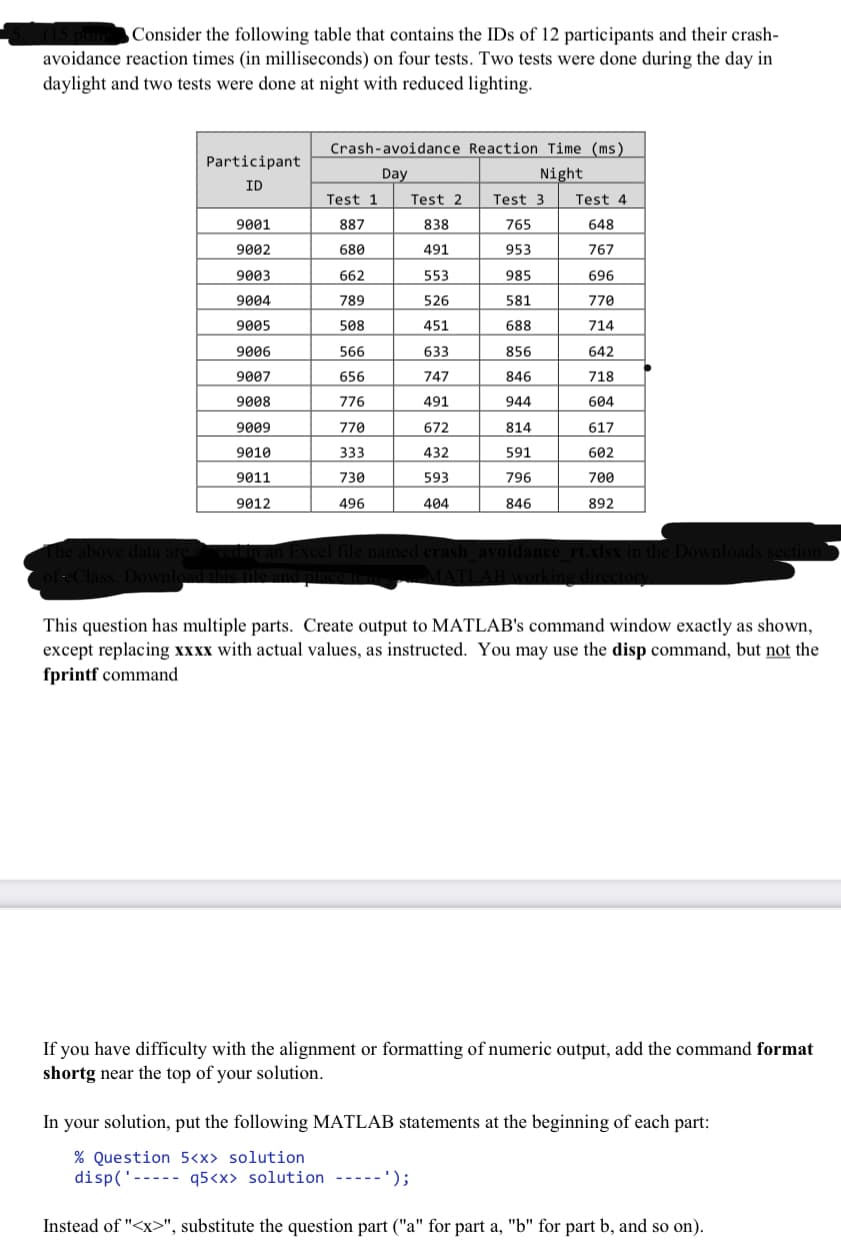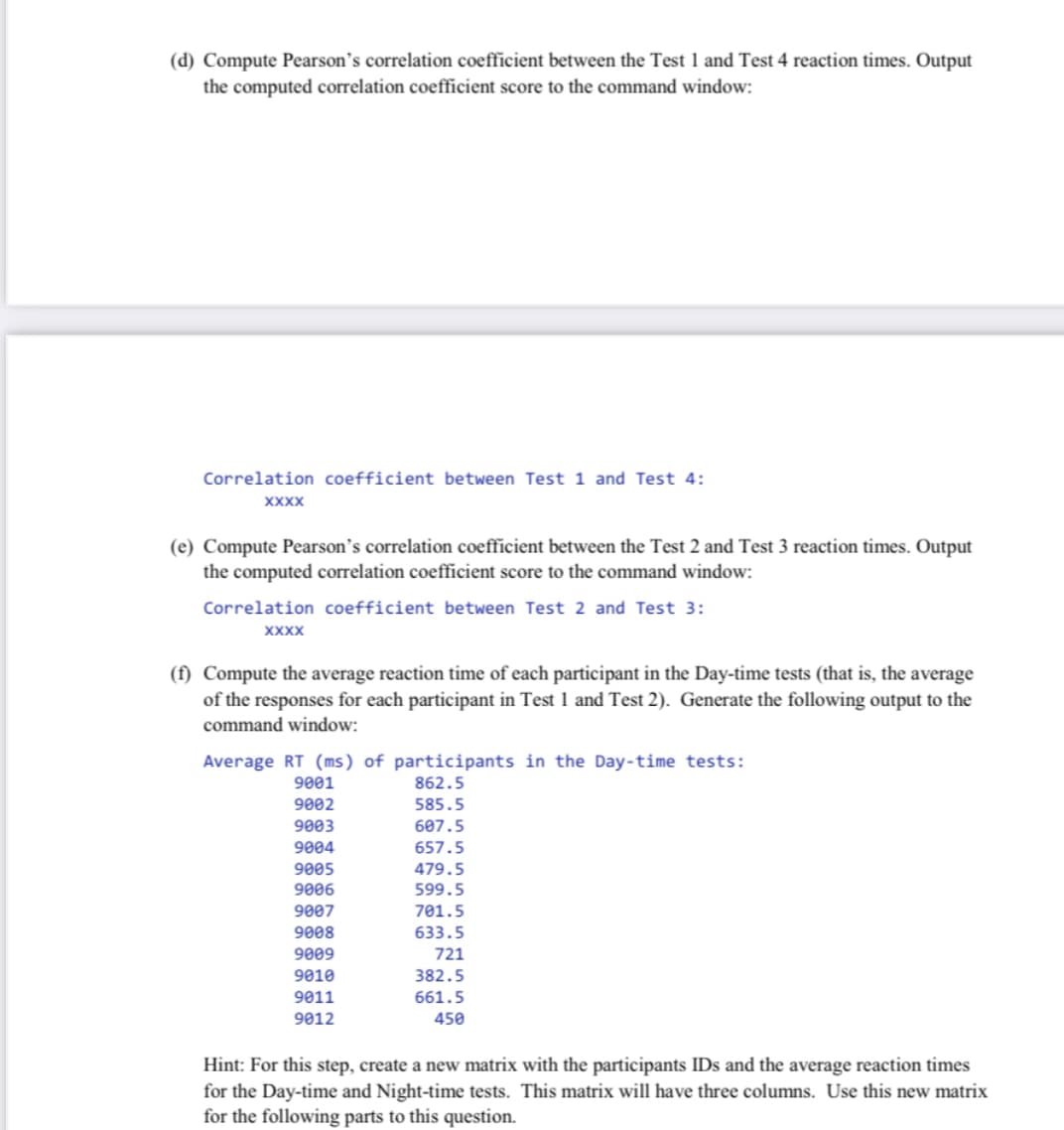(d) Compute Pearson's correlation coefficient between the Test 1 and Test 4 reaction times. Output the computed correlation coefficient score to the command window: Correlation coefficient between Test 1 and Test 4: XXXX (e) Compute Pearson's correlation coefficient between the Test 2 and Test 3 reaction times. Output the computed correlation coefficient score to the command window: Correlation coefficient between Test 2 and Test 3: XXXX (f) Compute the average reaction time of each participant in the Day-time tests (that is, the average of the responses for each participant in Test 1 and Test 2). Generate the following output to the command window: Average RT (ms) of participants in the Day-time tests: 862.5 9001 9002 585.5 9003 607.5 9004 657.5 9005 9006 479.5 599.5 9007 701.5 9008 633.5 9009 721 9010 382.5 9011 661.5 9012 450 Hint: For this step, create a new matrix with the participants IDs and the average reaction times for the Day-time and Night-time tests. This matrix will have three columns. Use this new matrix for the following parts to this question.
(d) Compute Pearson's correlation coefficient between the Test 1 and Test 4 reaction times. Output the computed correlation coefficient score to the command window: Correlation coefficient between Test 1 and Test 4: XXXX (e) Compute Pearson's correlation coefficient between the Test 2 and Test 3 reaction times. Output the computed correlation coefficient score to the command window: Correlation coefficient between Test 2 and Test 3: XXXX (f) Compute the average reaction time of each participant in the Day-time tests (that is, the average of the responses for each participant in Test 1 and Test 2). Generate the following output to the command window: Average RT (ms) of participants in the Day-time tests: 862.5 9001 9002 585.5 9003 607.5 9004 657.5 9005 9006 479.5 599.5 9007 701.5 9008 633.5 9009 721 9010 382.5 9011 661.5 9012 450 Hint: For this step, create a new matrix with the participants IDs and the average reaction times for the Day-time and Night-time tests. This matrix will have three columns. Use this new matrix for the following parts to this question.
Computer Networking: A Top-Down Approach (7th Edition)
7th Edition
ISBN:9780133594140
Author:James Kurose, Keith Ross
Publisher:James Kurose, Keith Ross
Chapter1: Computer Networks And The Internet
Section: Chapter Questions
Problem R1RQ: What is the difference between a host and an end system? List several different types of end...
Related questions
Question

Transcribed Image Text:Consider the following table that contains the IDs of 12 participants and their crash-
avoidance reaction times (in milliseconds) on four tests. Two tests were done during the day in
daylight and two tests were done at night with reduced lighting.
Crash-avoidance Reaction Time (ms)
Participant
Day
Night
ID
Test 1
Test 2
Test 3
Test 4
9001
887
838
765
648
9002
680
491
953
767
9003
662
553
985
696
9004
789
526
581
770
9005
508
451
688
714
9006
566
633
856
642
9007
656
747
846
718
9008
776
491
944
604
9009
770
672
814
617
9010
333
432
591
602
9011
730
593
796
700
9012
496
404
846
892
rt.xisx in the
This question has multiple parts. Create output to MATLAB's command window exactly as shown,
except replacing xxxx with actual values, as instructed. You may use the disp command, but not the
fprintf command
If you have difficulty with the alignment or formatting of numeric output, add the command format
shortg near the top of your solution.
In your solution, put the following MATLAB statements at the beginning of each part:
% Question 5<x> solution
disp('----- q5<x> solution -----');
Instead of "<x>", substitute the question part ("a" for part a, "b" for part b, and so on).

Transcribed Image Text:(d) Compute Pearson's correlation coefficient between the Test 1 and Test 4 reaction times. Output
the computed correlation coefficient score to the command window:
Correlation coefficient between Test 1 and Test 4:
XXXX
(e) Compute Pearson's correlation coefficient between the Test 2 and Test 3 reaction times. Output
the computed correlation coefficient score to the command window:
Correlation coefficient between Test 2 and Test 3:
XXXX
(f) Compute the average reaction time of each participant in the Day-time tests (that is, the average
of the responses for each participant in Test 1 and Test 2). Generate the following output to the
command window:
Average RT (ms) of participants in the Day-time tests:
9001
862.5
9002
585.5
9003
607.5
9004
657.5
9005
479.5
9006
599.5
9007
701.5
9008
633.5
9009
721
9010
382.5
9011
661.5
9012
450
Hint: For this step, create a new matrix with the participants IDs and the average reaction times
for the Day-time and Night-time tests. This matrix will have three columns. Use this new matrix
for the following parts to this question.
Expert Solution
This question has been solved!
Explore an expertly crafted, step-by-step solution for a thorough understanding of key concepts.
Step by step
Solved in 2 steps with 1 images

Recommended textbooks for you

Computer Networking: A Top-Down Approach (7th Edi…
Computer Engineering
ISBN:
9780133594140
Author:
James Kurose, Keith Ross
Publisher:
PEARSON

Computer Organization and Design MIPS Edition, Fi…
Computer Engineering
ISBN:
9780124077263
Author:
David A. Patterson, John L. Hennessy
Publisher:
Elsevier Science

Network+ Guide to Networks (MindTap Course List)
Computer Engineering
ISBN:
9781337569330
Author:
Jill West, Tamara Dean, Jean Andrews
Publisher:
Cengage Learning

Computer Networking: A Top-Down Approach (7th Edi…
Computer Engineering
ISBN:
9780133594140
Author:
James Kurose, Keith Ross
Publisher:
PEARSON

Computer Organization and Design MIPS Edition, Fi…
Computer Engineering
ISBN:
9780124077263
Author:
David A. Patterson, John L. Hennessy
Publisher:
Elsevier Science

Network+ Guide to Networks (MindTap Course List)
Computer Engineering
ISBN:
9781337569330
Author:
Jill West, Tamara Dean, Jean Andrews
Publisher:
Cengage Learning

Concepts of Database Management
Computer Engineering
ISBN:
9781337093422
Author:
Joy L. Starks, Philip J. Pratt, Mary Z. Last
Publisher:
Cengage Learning

Prelude to Programming
Computer Engineering
ISBN:
9780133750423
Author:
VENIT, Stewart
Publisher:
Pearson Education

Sc Business Data Communications and Networking, T…
Computer Engineering
ISBN:
9781119368830
Author:
FITZGERALD
Publisher:
WILEY